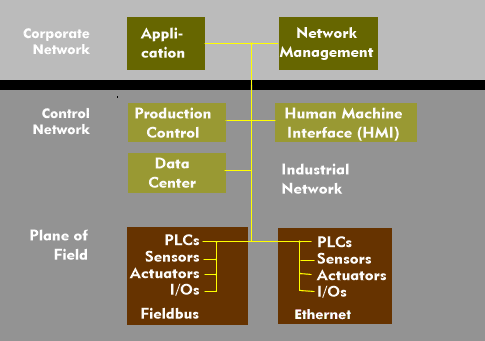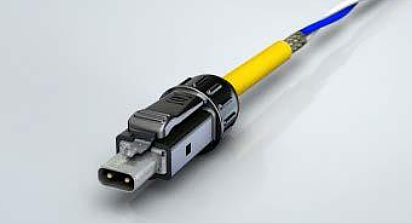industrial Ethernet (IE)
Industrial Ethernet ( IE) is the implementation of Ethernet in industrial plants. Unlike office applications, reliable real-time capability must be ensured for industrial applications. This is not supported by the classic Ethernet approach because the CSMA/CDaccess method accesses the network stochastically. There are about 20 protocols for Industrial Ethernet, which are based on IEEE 802.3
The fieldbus protocols are transmitted via Ethernet using tunneling or encapsulation. The advantages lie in the continuity of the communication systems from the fieldbus via the company networks and the Internet into the IP world. Furthermore, the simple portability and the direct adoption of the application layer of the fieldbus.
The discontinuation of real-time capability due to the non-deterministic Ethernet, the large overhead when using the TCP protocol and the principle of retaining a proprietary system have a negative effect. The developments towards real-time Ethernet are supported in Europe by various Ethernet protocols. Thus by EtherCAT, EtherNet/IP, TTEthernet, Ethernet-Powerlink, Profinet, Sercos III and CC-Link IE, but also in the USA where some associations like the Open DeviceNet Vendor Association( ODVA), ControlNet International( CI) and the Industrial Ethernet Association (IEA) favor these solutions.
Work on EtherNet/IP, which is based directly on the lower layers of Ethernet and incorporates all known Ethernet components, is very advanced. The decisive protocol for industrial applications is the Common Industrial Protocol( CIP), which supports cyclic and time-critical data traffic in automation technology. CIP networks are interoperable with each other, so that, for example, a DeviceNet can work with an EtherNet/IP.
Industrial Ethernet data rates range from 10 Mbit/s to 1 Gbit/s, with 100 Mbit/s being the most commonly used data rate.
Industrial Ethernet uses the cabling standards
In terms ofcabling, industrial Ethernet consistently relies on international cabling standards such as ISO/IEC11801, which forms the cabling structure for all factory and hall networks. The essential aspects ofservices and applications are anchored in the ISO/ IEC 24702 standard. Single-pair cables are an alternative to the classic TP cables. For this, there is One-Pair Ethernet( OPEN) with the interface100Base- TX and Single-Pair Ethernet( SPE) and the SPE cabling.
For Industrial Ethernet the most different connector types are used. As circular connectors the M8 connector and the M12 connector, the widely used RJ45 connector with IP67protection, the iX connector from Harting and several others. For Single-Pair Ethernet (SPE), various SPE connectors have been standardized under IEC 63171.


